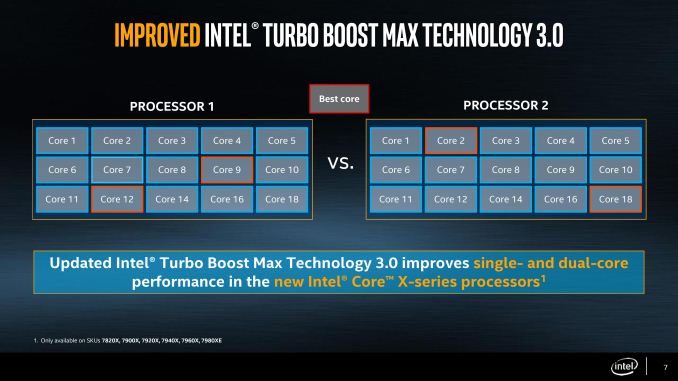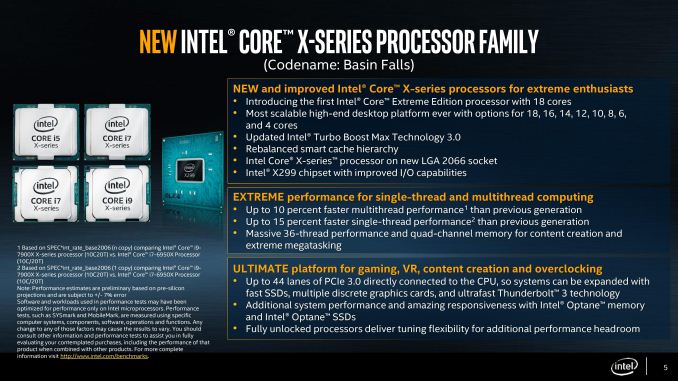Intel Announces Skylake-X: Bringing 18-Core HCC Silicon to Consumers for $1999
by Ian Cutress on May 30, 2017 3:03 AM ESTAnnouncement Four: AVX-512 & Favored Core
To complete the set, there are a couple of other points worth discussing. First up is that AVX-512 support coming to Skylake-X. Intel has implemented AVX-512 (or at least a variant of it) in the last generation of Xeon Phi processors, Knights Landing, but this will be the first implementation in a consumer/enterprise core.
Intel hasn’t given many details on AVX-512 yet, regarding whether there is one or two units per CPU, or if it is more granular and is per core. We expect it to be enabled on day one, although I have a suspicion there may be a BIOS flag that needs enabling in order to use it.
As with AVX and AVX2, the goal here is so provide a powerful set of hardware to solve vector calculations. The silicon that does this is dense, so sustained calculations run hot: we’ve seen processors that support AVX and AVX2 offer decreased operating frequencies when these instructions come along, and AVX-512 will be no different. Intel has not clarified at what frequency the AVX-512 instructions will run at, although if each core can support AVX-512 we suspect that the reduced frequency will only effect that core.
With the support of AVX-512, Intel is calling the Core i9-7980X ‘the first TeraFLOP CPU’. I’ve asked details as to how this figure is calculated (software, or theoretical), but it does make a milestone in processor design. We are muddying the waters a bit here though: an AVX unit does vector calculations, as does a GPU. We’re talking about parallel compute processes completed by dedicated hardware – the line between general purpose CPU and anything else is getting blurred.
Favored Core
For Broadwell-E, the last generation of Intel’s HEDT platform, we were introduced to the term ‘Favored Core’, which was given the title of Turbo Boost Max 3.0. The idea here is that each piece of silicon that comes off of the production line is different (which is then binned to match to a SKU), but within a piece of silicon the cores themselves will have different frequency and voltage characteristics. The one core that is determined to be the best is called the ‘Favored Core’, and when Intel’s Windows 10 driver and software were in place, single threaded workloads were moved to this favored core to run faster.
In theory, it was good – a step above the generic Turbo Boost 2.0 and offered an extra 100-200 MHz for single threaded applications. In practice, it was flawed: motherboard manufacturers didn’t support it, or they had it disabled in the BIOS by default. Users had to install the drivers and software as well – without the combination of all of these at work, the favored core feature didn’t work at all.
Intel is changing the feature for Skylake-X, with an upgrade and for ease-of-use. The driver and software are now part of Windows updates, so users will get them automatically (if you don’t want it, you have to disable it manually). With Skylake-X, instead of one core being the favored core, there are two cores in this family. As a result, two apps can be run at the higher frequency, or one app that needs two cores can participate.
Availability
Last but not least, let's talk about availability. Intel will likely announce availability during the keynote at Computex, which is going on at the same time as this news post goes live. The launch date should be sooner rather than later for the LCC parts, although the HCC parts are unknown. But no matter what, I think it's safe to say that by the end of this summer, we should expect a showdown over the best HEDT processor around.


















203 Comments
View All Comments
nevcairiel - Tuesday, May 30, 2017 - link
I doubt you'll see a 16-core for less then $1000alamilla - Tuesday, May 30, 2017 - link
I'm placing my bets at $999 for the 16 core.What I'm getting at, and to some extent jjj, is that the cost of entry will still be significantly lower. I wouldn't be surprised to see lower tier X399 boards come in at $180-200.
mdw9604 - Tuesday, May 30, 2017 - link
They are trying not to canabilize their server market. Even though these are not server chips. AMD is making them earn their place in the chip world.Socaltyger - Tuesday, May 30, 2017 - link
All at once now... "Thank you AMD".Gothmoth - Tuesday, May 30, 2017 - link
+1soydeedo - Tuesday, May 30, 2017 - link
No kidding. I have to say I'm kind of glad that intel isn't looking to take losses to undercut AMD while they're still in a somewhat vulnerable position. We desperately needed this competition.Gothmoth - Tuesday, May 30, 2017 - link
the 18 core is a cpu for bragging rights.a few youtuber will get it from intel to promote it.
a few 1% will buy it or bragging rights.
and intel can still say they have the fastest enthusiast CPU.
but how many mortals will buy it?
Gothmoth - Tuesday, May 30, 2017 - link
just read the tread about 10 core broadwell-e maybe being the best selling HEDT cpu.that suprises me.
i live in europe. i am an engineer. my friends too have well payed jobs.
but i don´t know a single person who would spend 1700$ (not to mention euro) on a CPU.
so who is buying the huge amount of HEDT CPU´s?
is it such a well received CPU for companys?
would they not go for xeon systems anyway?
Kevin G - Tuesday, May 30, 2017 - link
I suspect that the 10 core Broadwell-E sales were upgrades from lower core count Haswell-E systems. I suspect that very few people went out and built a system from scratch with the 10 core chip. Rather they started with low and then upgrades since X99 motherboards were going to be around for awhile (~3 years).damianrobertjones - Tuesday, May 30, 2017 - link
Capitals. Sentences need capitals my Man.